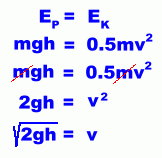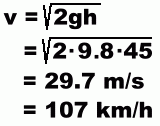|
This ride is so terrifying, they actually charge you an extra $18 to go on it. (All the other rides are free with admission) People are lined up here all day! You can be by yourself, or with a group of three, tightly tied onto a little mat that is hoisted 45 metres into the air and allowed to drop. You swing, at almost 100 km/h near the bottom. Just over the heads of passersby. During the Spanish Inquisition they would have paid good money for a torture device this effective!
Here's the picture again, after the cables used to haul you into position have let go. The length of the pendulum cable L determines how long your swing will be. (This is called the period of the swing). The usual equation for relating the period T and length L of a pendulum, as studied in Physics 20, is: where g is the acceleration of gravity, 9.8 m/s2 We can't use this equation reliably here, because it only works for small angles of release. From the picture, you can see that the riders are pulled to a 90° angle ... too large to use this formula. We can however do a simple calculation to check the speed at the bottom. When the riders have been hoisted up to the left, their height above the ground is h. Their potential energy Ep due to height is given by the formula Ep = mgh, where m is the total mass of them and the mat. At the bottom of the first swing, when they have essentially been in freefall, and are close to the ground, their height is close to zero, and almost all of their energy due to height has been transformed into kinetic energy of motion. Their kinetic energy Ek at this point is given by the formula EK = 0.5mv2, where v is their speed. The original potential energy must be about equal to the kinetic energy it turned into. In other words, EP = EK. By equating the formulas, we can solve for an expression for speed. Here's the algebra:
(Because the pendulum does not let you descend the full 45 m, you don't get quite as much kinetic energy, and of course, friction in the cable mechanism is causing you to lose some energy too). |

